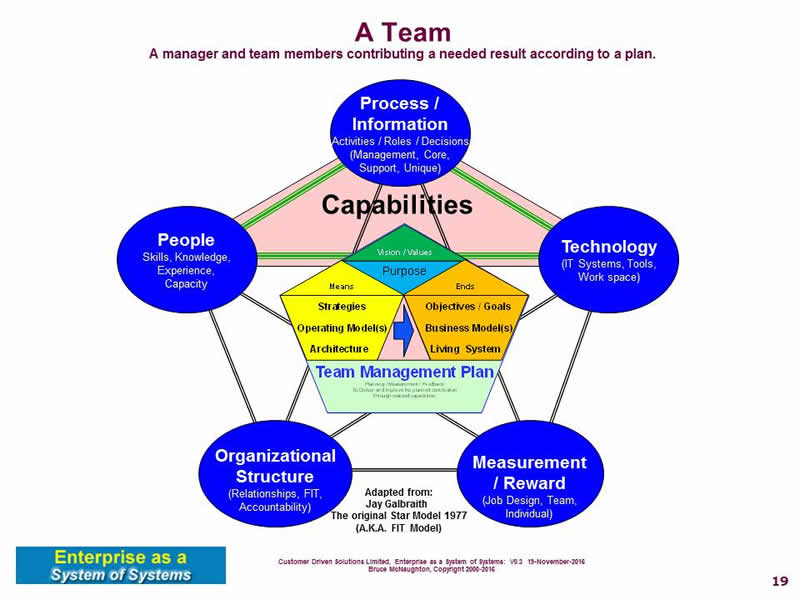Description
The Operating Model describes the way an the enterprise or an organization delivers value to its stakeholders.
An operating model is established by a top management team as the way to realize the strategies to achieve its purpose. The top management team is defined as:
ISO 9000:2015: Top Management Team: person or group of people who directs and controls an organization at the highest level
This top management team establishes the scope of the operating model at their level within the Enterprise. This can be:
-
The whole Enterprise
-
A specific Organization
-
A single Team
The Operating Model describes the Design of an Organization. The Operating Model describes the organization at specific points in time:
-
Current Operating Model: The design of the current state Organization or whole Enterprise.
-
Intermediate Operating Model: The design of the organization at a specific point in time during the transition to the Target Operating Model
-
Target Operating Model: The design of the Desired future state of the organization or the enterprise.
The Operating Model is also related to the following architectural / design documents:
-
Enterprise (SoS) Architecture Description created using the Link to the Enterprise (SoS) Architecture Description Framework)
-
Enterprise and Technology Architectures using the TOGAF Architecture Framework.
-
Architecture Descriptions using the Universal Architecture Framework (UAF).
-
Blueprint (2011 version or earlier) or Target Operating Model (2019) using the Program Management business process, Managing Successful Programes.
-
Various Organizational Design (OD), Business Change or management approaches that describe the future state of the enterprise or organization (See Management References)
The operating model can also be seen as a scalable operating model using a multi-dimensional approach. This multi-dimensional approach to organization design has been described by Russell Ackoff and Jay Galbraith.
Contents
All of these approaches identify similar information to be included in the Description of the Operating Model:
-
Organizational Information
-
Organizational Structure
-
Measurement and Rewards
-
-
Capabilities
-
People with Skills, knowledge and experience
-
Process including Information
-
Technology.
-
-
Strategy, Objectives and Plans
In this approach to the Operating Model, we have adopted / adapted the STAR Model from Jay Galbrath as the model of an operating model:

This model can be used to describe the entire Enterprise Operating Model or a single team (organization).
Languages, Notations, Conventions
All of the elements in the operating model are defined in the following Enterprise (SoS) System Description
PDF: System Description: Enterprise as a System of Systems (SoS),
In addition, the conventions used for creating the Enterprise Architecture Description are based upon architectural practices based upon ISO 42010:2022.
Methods - Create, Analysis, Identify
The methods used to create the resulting design of the Operating Model (any version) are based upon typical change management practices:
-
Managing Successful Programmes, a Program Management Process.
-
Architecture Frameworks: the instructions to create Architecture Descriptions based upon Architecture Viewpoints.
-
Various Organization Design approaches (using the STAR Model, etc)
The Operating Model can be created as an Enterprise (SoS) Architecture Description using the Link to the Enterprise (SoS) Architecture Description Framework
Modelling Techniques
Many of the examples in the Enterprise as a System of Systems (SoS) websute use the Unified Modelling Language (UML) as an Architecture description Language.
When using the architectural approach from ISO 42010:2022, the definition of the views and which models need to be created are provided in the Viewpoint. The Model Kind documents (such as this one) provide the details of a specific model. In this case, the Operating Model is a type of text and models integrated into a single package.
Examples
Examples of Enterprise (SoS) Architecture Descriptions are currently in development (two from the Sports area).
-
Formula One Racing (Entertainment Organizations)
-
National Football League (Entertainment Organizations)
Given the confidentiality of the Operating Models, there are few in the public domain. Typical examples are found in training courses.
Example Operating Model Headings from Managing Successful Programmes, 2019, aligned to the STAR Model operating model structure
Organization Structure
-
Organize
Measurements and Rewards
Capabilities
-
Capabilities.
People.
-
Knowledge and Learning
-
Culture
Process.
-
Processes
-
Information and Data
Technology.
-
Technology. (typically IT)
-
Infrastructure. (typically Physical Infrastructure)
Enterprise Plan.
References
Model Kind Links